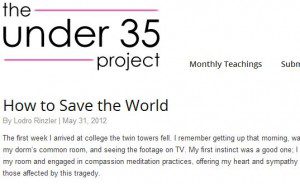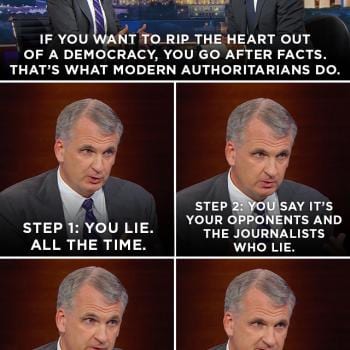Today I’m honored to host the writing of Lodro Rinsler, author of “The Buddha Walks into a Bar” (reviewed here) who introduces Shambhala Publications “under 35 project.” Here is a quick introduction by Lodro, along with one of his recent writings:
Over the last few months Shambhala Publications, one of the world’s pre-eminent publishers of books on enlightened living, has begun a conversation on what it means to bring mindfulness and compassion to every aspect of our lives. This conversation takes place on the Under 35 Project (under35project.com).
Each month we’ll contemplate a different topic—be it relationships, work, parenting, or health—and invite you to share your experience. In June we tackled the topic of social action; below is a piece I myself wrote on the topic. In July we will explore starting and deepening your meditation practice, and Shambhala author Susan Piver will lead us in that discussion. To join in click here: http://www.under35project.com/submit/
~
How to Save the World
The first week I arrived at college the twin towers fell. I remember getting up that morning, walking into my dorm’s common room, and seeing the footage on TV. My first instinct was a good one; I returned to my room and engaged in compassion meditation practices, offering my heart and sympathy for all of those affected by this tragedy.
After that initial wave of heartbreak passed, I became outraged. It was only a few weeks later that I, along with three hundred others, took to the streets of Hartford, Connecticut. We were protesting what we perceived as the knee-jerk reaction of the US government in bombing Afghanistan. In my mind, the swift and deadly response to the September 11 attacks was unjust and was likely to hurt more innocents than terrorists, further fueling the fires of aggression that have engulfed our world.
I was just one man lost in a wave of anger and frustration, overwhelmed by the emotions of those chanting and bustling around me. Meanwhile, police officers began to set up roadblocks and attempted to break up the protest. Their rage over the 9/11 attacks fueled our own and before too long the protest erupted into violence.
From there I only have broken images. A police officer daring me to step off the sidewalk and embrace arrest. A sixty year old man being struck, falling to the ground, and wailing “I can’t see! I think they broke my ribs!” Police officers hovering, menacingly, over him. A look of pure hatred on the face of one such officer as he held up a can of pepper spray. A lobby of people unwilling to let me wash the burn from my eyes and neck. A group of downtrodden protestors handcuffed together in the back of a paddy wagon. A processing officer telling me that I wouldn’t make it through the weekend in jail; that I would be beaten to death by my own shoes.
I spent forty-eight hours in jail and during that time I began to reflect on how I ended up facing criminal charges, surrounded by murderers and drug dealers, and a part of the first major protest arrest post-9/11. One conclusion I came to is that I do not regret moving to aide that older gentleman. He was hurt and my instinct was to help. I cannot fault nor would I want to change that instinct.
At the same time, I could not help but feel that my years of meditation training had gone out the window that day. International violence had begot international violence, striking the United States a crushing blow. My initial instinct to touch base with my own sadness was eventually clouded over in the midst of a nationwide atmosphere of anger and terror. I had become lost in the post-9/11 fog. I had become the problem, as opposed to the solution, by letting my rage fuel my actions in the midst of a protest. I did not represent the peace I wanted to see in the world that day, only the fear and chaos that it was engulfed in.
When strong emotions like anger and fear arise on the meditation cushion, I know to cut through them gently yet decisively. It could be feeling like a co-worker is treating me unfairly, that I am worried about my parents’ health, or that I am reliving an angry conversation that happened hours ago. Regardless of the storyline I can recognize the underlying emotions and, before getting caught up in them, see them as impermanent, as something other than what is currently going on in my present experience. From there I return to the breath. This is my practice on and off the meditation cushion and, to be honest, I have gotten pretty good at it since that day.
Yet ten years ago, when faced with a surging crowd of protestors and an equally charged crowd of officers of the law, I caved in. I bought into the generations-old storyline of “us” versus “them.” I gave into the belief that we were in the right, which meant the police officers must have been in the wrong. I stopped listening to my own innate wisdom and instead gave in to the same sense of dualism that snowballs into violence and destruction – the same enraged polarized notions that created the 9/11 tragedy in the first place.
Throughout the following year, as I attended court dates and met with my parole officer, I had time to reflect on my mistake and how our generation has a real opportunity to do something radical and, in my opinion, more productive to create social change in the world.
I won’t knock anyone who wants to peacefully protest. At the same time, the poster person for peaceful protest, Gandhi, once said that we should strive to be the change we want to see in the world. That day in Hartford no one represented peaceful change. International protests today seem to bear the same feelings of dualistic aggression as the Hartford protest ten years ago. An angry protestor demanding peace seems paradoxical. So what can we as young people in the West, do to make our voices heard in a skillful and compassionate manner? How can we create change through representing our ideals?
Step 1: Cutting through Fixed Views
The first step is to learn to work with our set expectations. We all have them. The idea for what the world would be like if only X, Y, and Z would change. The utopia we know we could achieve if only the right people were elected, the right economic checks were put in place, the right sorts of companies were given a chance to succeed.
The thing with these fixed views is that they are the basis for that dualistic thinking I mentioned before. If you go into the world with the notion that your opinions are better than everyone else and try to force them down people’s throats you are only propagating aggression.
Instead, you can meditate and examine where these fixed views come from. You sit on the cushion, breath after breath, and watch the display of your mind. As thoughts come and go it’s almost like you’re watching a really funny, scary, and sometimes obnoxious movie play out, right before your eyes. Yet you can just watch this display, gently coming back to the breath over and over again.
At a certain point you may see themes come up repeatedly. This is when you can begin to discern how you get hooked by fixed views. You might even develop a sense of humor about it. In some sense, it’s absurd that you can be sitting in your apartment yet your mind will be re-hashing a confrontation you had with a colleague, perpetuating that idea that you’re right and they are wrong. That confrontation happened days ago! To overcome this habitual pattern, you can gently return to something that is unwaveringly true: the present moment. By continuously coming back to the present, you are learning to free yourself from fixed points of view.
Step 2: Raise Your Gaze
As you get to know your mind, you see where you get stuck by fixed emotions but they don’t get their hooks into you like they used to. Then you start to recognize people around you similarly lost in a fog of their own emotional states.
Perhaps you used to be dragged around by strong emotions. Perhaps it felt like you were lost in a waterfall of passion, aggression, and prejudice. However, because of serious hours logged on the meditation cushion, that waterfall seems less overwhelming – now it is more like a stream. You’re not hopping off the cushion enlightened, but you have a greater familiarity with your own habitual patterns and aren’t acting as much like a jerk as you used to.
From this new perspective, you can wade around in that stream and have more room to focus on others, not just you. You begin to see how others are caught in their own waterfall of emotions and dualistic thinking. You might even have an epiphany – they want to be happy, just like me. They want to be of benefit to others – just like me. From the recognition that everyone around us experiences the same things we do compassion naturally dawns. You feel a tug at your heart and you want to help them out from under their own personal waterfalls of fixed view.
Step 3: Compassionate Activity
At this juncture, we can take this experience of compassion and commit to a new motivation: we want to be of benefit. We can have faith that it’s possible to be of benefit, because we’re not as attached to our own fixed expectations as we were before. Instead of trying to yell our point of view into existence, we have the opportunity to infiltrate the same organizations we seek to change and create the change from within. We can maintain an open heart, even in the toughest of corporate settings, and let our compassion touch others.
I realize this is easier said than done. But really, what’s the alternative? Live outside “the system” and only hang out with people who share the same ideals as us? Is our intention, as a generation, to create that sort of fringe or cult society? Or to change the world we grew up in?
I believe it’s the latter. I believe that there are thousands, if not millions, of young people out there who want to live their lives in accordance with their own noble heart. Who want to start a business based on compassionate activity, or run a team within their company dedicated to mindfully listening to one another and encouraging each other, or to create art that will inspire others to be kinder people. I believe we are a generation that wants to create positive change yet has not woken up to our potential to do so. In my opinion, this potential resides within the same system we are living in today.
I think that through embodying the compassion practices we so often practice, we will become known as kind and trusted leaders. People at school, or work, or even our own families will naturally pick up on the positive energy we are putting out. They will be inspired and, in the face of compassion, often they will adapt their behavior to be more accepting and open as well.
If we can continuously connect to the power of our own open heart, I believe we can indeed create societal change over time. It might not always look like what we thought it would but I’m pretty damn sure it will be more effective than rampaging through the streets yelling slogans.
Ten years after 9/11, that’s what I’m trying to do. I invite you to join me.
(view the original here)












